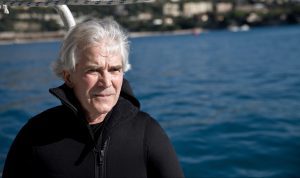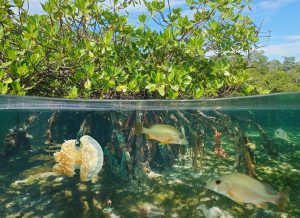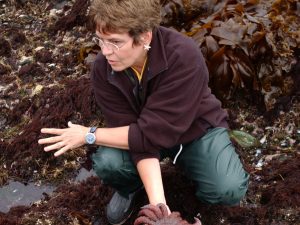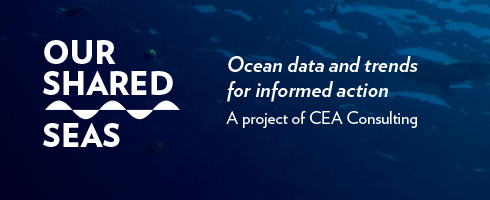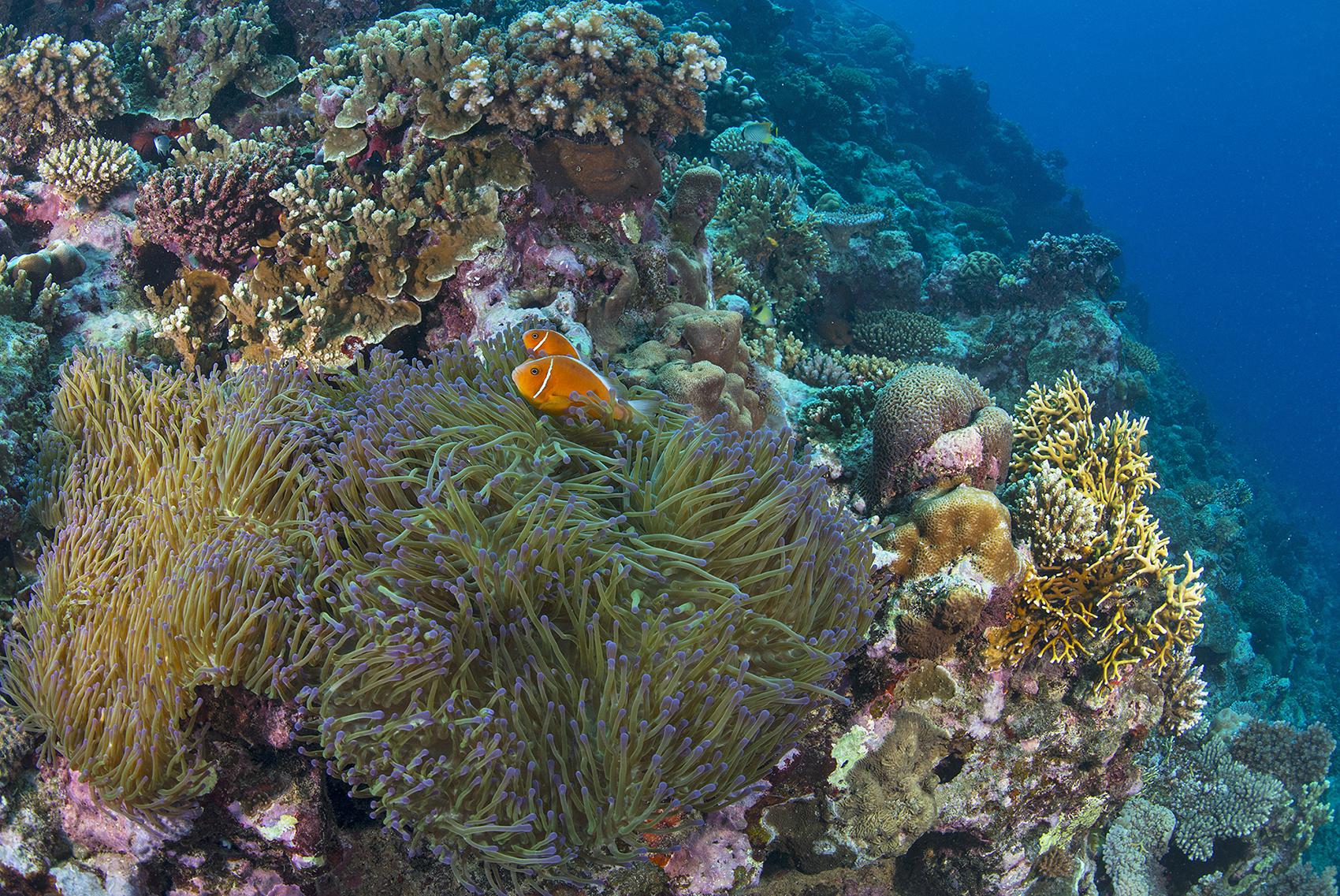
Photo: Jayne Jenkins / Coral Reef Image Bank
Interconnections between climate change and marine biodiversity
Although frequently viewed as siloed crises, climate change and biodiversity are inextricably connected, particularly in the ocean. Understanding these interconnections is key to addressing these twin threats and implementing solutions with higher likelihood of success. Anthropogenic greenhouse gas emissions, particularly carbon dioxide (CO2), impact the ocean in several profound ways. A quarter of all CO2 emissions are absorbed by the ocean, thereby acidifying its productive surface layers to the detriment of calcifying organisms.1 The ocean also absorbs 90 percent of excess heat from the atmosphere, leading not only to increased seawater temperatures but also to sea level rise and hypoxic zones.2 Species that have evolved to survive in delicately balanced ocean ecosystems are now facing rapid biogeochemical changes of their habitats.
Globally, climate change has become the biggest and fastest growing threat to marine biodiversity. Biodiversity in the ocean has evolved in the absence of human-induced stressors such as overfishing, pollution, shipping, habitat destruction and fragmentation, and invasion of new species. Even without climate change, this ‘cumulative human impact’ (CHI) on the ocean has considerably diminished marine biodiversity. Unfortunately, the effects of climate change have now become the biggest and fastest growing contributors to CHI.3 A recent report from the Intergovernmental Science-Policy Platform on Biodiversity and Ecosystem Services found that approximately one million plant and animal species are threatened by extinction, many within decades, and that human activities have significantly altered two-thirds of the ocean.4 As a general pattern, tropical regions often experience a loss of species due to elevated heat stress, whereas temperate regions increase in net diversity, as species migrate poleward.5 Efforts to keep climate change well below 2 degrees Celsius above pre-industrial levels are now needed to prevent climate impacts from overwhelming all other actions in support of biodiversity.
The ocean plays a key role in both mitigating climate change and in buffering the impacts of climate change on marine biodiversity. Carbon dioxide diffuses into the surface layer of the ocean whenever it is more abundant in the air than in the water. Once dissolved, powerful biological, physical, and chemical carbon pumps remove CO2 from the surface, pulling yet more of it into the ocean. These marine carbon pumps make the ocean an important ally in the fight against climate change; it is critical to strengthen and protect them for their mitigation function. As an adaption function, a healthy ocean can provide much-needed resources to organisms, populations, and ecosystems as they struggle to overcome adverse effects of climate change. Much like vitamin C can increase our resilience in flu season, a thriving ocean can increase the resilience of the most vulnerable ecosystems to temperature increases, changes in pH and hypoxic conditions.
Several international policy targets and agreements—including the 2030 Agenda for Sustainable Development, the Aichi Biodiversity Targets, and the Paris Agreement under the UN Framework Convention on Climate Change—recognize the interconnectedness of biodiversity and climate change. Given that climate change is a major driver of biodiversity loss and that declines in biodiversity undermine efforts to address climate change, these twin crises continue to threaten progress on key global targets. The Intergovernmental Panel on Climate Change (IPCC) has long emphasized the significant differences in the outcomes for biodiversity depending on whether global temperature increases can be kept close to 1.5 degrees Celsius or whether they exceed 2 degrees Celsius above pre-industrial levels. The 2015 Paris Agreement consequently produced a global consensus on taking ambitious action. Simultaneously, the IPCC recognizes that around one third of the net reductions in greenhouse gas emissions required to meet the Paris Agreement’s goals could come from ‘nature-based solutions.’6 Most recently, the UN Global Biodiversity Outlook 5 outlined eight opportunities for transition to achieve the 2050 Vision for Biodiversity. Among these transition pathways, the report identified climate action as a priority to reduce the scale and impacts of climate change, and to provide positive benefits for biodiversity.7
Potential role of Marine Protected Areas (MPAs) for climate mitigation
By halting habitat degradation and preserving the integrity of marine food webs, MPAs can play an important role in boosting marine carbon sequestration and avoiding emissions. Healthy and productive coastal and ocean ecosystems play two important mitigation roles. First, they contribute to the flow of carbon from the atmosphere to coastal soils, ocean sediments or just the deep ocean through photosynthetic fixation and the movement of carbon through the food web, at which point it can be considered “permanently sequestered”. Second, they safeguard the stock of organic carbon that has been sequestered over millennia and is stored in thick layers of coastal soils and seabeds. Recent academic literature suggest that MPAs might have an important role to play in maintaining a high rate of carbon flow and in keeping the carbon stock safely isolated from respiring back into the atmosphere.8 However, this potential is largely limited to blue carbon ecosystems:
- Blue carbon ecosystems: Analysis suggests that, globally, the complete halt of mangrove and seagrass degradation has a mitigation potential of 0.17 – 0.5 gigatons of carbon per year by 2030, equivalent to approximately 0.5 percent of 2018 emissions.9
- Open ocean ecosystems: Quantifying the mitigation potential of MPAs in open ocean settings is much more difficult, particularly due to our limited understanding of the biological pump and knowledge gaps related to the role of marine fauna in cycling and sequestering organic carbon.10 Approximately 0.1 percent of phytoplankton production is ultimately sequestered in the deep ocean and in sediments and it is “not clear if there is any additional sequestration value resulting from fish consumption and subsequent excretion.”11 In other words, while marine fauna plays an important role in cycling organic carbon through the food web, the improved management of commercial fish species, might not contribute to the permanent sequestration of organic carbon.
- Sea beds. Marine reserves, particularly in the high seas, could become a tool to zone and manage the impacts of sea bed mining.
Potential role of MPAs for climate adaptation for marine biodiversity
Certain marine ecosystems and locations can serve as climate refugia or facilitate species adaptation. As an example, the decline in seawater pH due to ocean acidification remains a pervasive threat to organisms and ecosystems. However, there is substantial natural variation in the severity of pH exposures across marine ecosystems, latitudes, and time (season, day, etc.). Such natural variation in pH creates both a) ocean acidification refugia, where species are naturally protected from the most harmful conditions, and b) adaptation hotspots, where species have developed tolerances to otherwise harmful conditions overtime.12 (Identification of climate refugia and adaptation hotspots, and their protection and integration with spatial marine planning, can help build the resilience of marine ecosystems to climate change.
MPA design can anticipate shifts in species distribution and provide migration corridors and landing zones. The effects of climate change in the ocean will involve range shifts towards the poles, likely causing an overall decrease in biodiversity at the equator and the tropics, and an increase in biodiversity at higher latitudes. Some species, populations, communities or even habitats will move, disappear, or decrease drastically; they will be replaced by others, indigenous, migrant or non-native species that will eventually prosper. These bio-geographical changes will lead to a global reorganization of the distribution and abundance of the species, and will be highly variable in time and space.13 Anticipating these range shifts and migration patterns is challenging but MPAs might be particularly well-suited to protect large ocean areas that decrease the adverse impacts of these macro-changes on affected species.14
Additional research is needed to understand the extent to which MPA can address the complex and dynamic challenges induced by climate change. Well-designed and well-enforced no-take reserves have shown to increase abundance, species richness, and size of organisms, but significant knowledge gaps remain in assessing whether static MPAs can achieve ecological objectives of marine biodiversity conservation and fisheries management.15–17 Climate change will introduce new complexities and calls for adaptive and dynamic management approaches.18
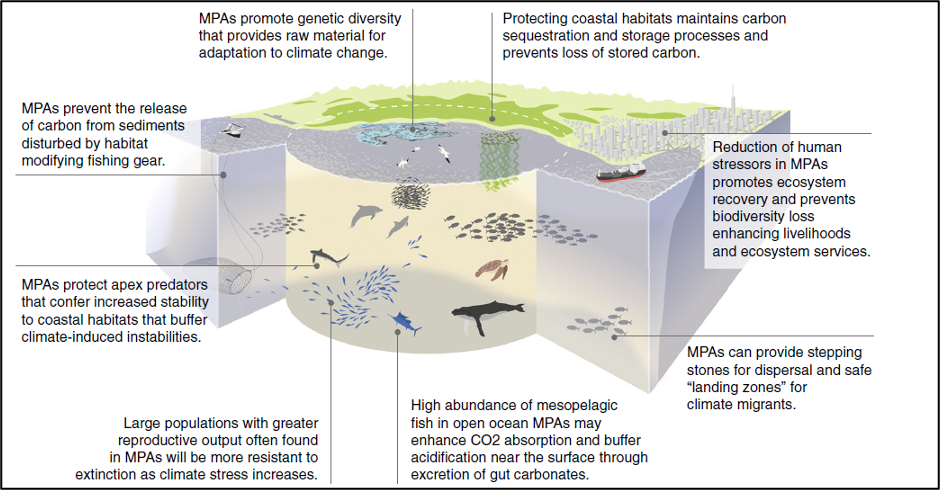
Figure 1: Eight illustrative pathways by which MPAs can mitigate and promote adaptation to the effects of climate change. Source: Roberts, Callum M., Bethan C. O’Leary, Douglas J. McCauley, Philippe Maurice Cury, Carlos M. Duarte, Jane Lubchenco, Daniel Pauly, et al. “Marine Reserves Can Mitigate and Promote Adaptation to Climate Change.” Proceedings of the National Academy of Sciences 114, no. 24 (June 13, 2017): 6167–75. https://doi.org/10.1073/pnas.1701262114.
An action list for the marine conservation community
As the planet faces unprecedented pressures from climate impacts and biodiversity decline, the marine conservation community faces an urgent need to pursue evidence-based solutions to these twin crises. Promising opportunities for action by the marine conservation community include the following:
- There is emerging opportunity to bring climate and biodiversity under a shared agenda, with MPAs as one important tool in a portfolio approach. In the Global Biodiversity Outlook 5, the Secretariat of the Convention on Biological Diversity observes that, “Many of the measures that are required to tackle poverty, reduce hunger, tackle climate change and reduce the risk of future pandemics are also those that are needed to support biodiversity, so there is potential for a powerful shared agenda.”19 Highlighting the shared goals of biodiversity not only with those of climate mitigation and adaptation efforts but also with other Sustainable Development Goals can strengthen the case of a portfolio approach and cement MPAs as one key management tool that can complement more traditional approaches, including fisheries management.
- Climate mitigation and adaptation provide key policy and public funding opportunities. Opportunities over the next two years (e.g., the ABNJ, BBNJ agreement, and the CBD Conference of Parties in 2021) offer the chance to adopt a new target of protecting 30 percent of the global ocean by 2030 and to accelerate ocean action. Philanthropy could help drive the ambition of such policy frameworks by enabling the coordination of NGOs and multi-lateral organizations, some of which have been instrumental in elevating these talking points to UN level. Increased alignment of climate and biodiversity finance represents a real and growing opportunity.
- There is a need for better quantitative toolboxes to inform climate-smart MPA design. Understanding, predicting, and abating drivers of biodiversity loss requires large amounts of data, including biological, biogeochemical and physical time series (e.g. productivity and ecosystem function, species composition, allelic diversity, and genetic expression), but also social and economic indicators.20 The design, governance and practical application of such integrated data systems benefits from multi-sectoral collaborations and could be hosted by marine NGOs that have demonstrated leadership of such efforts in the past.
- Co-management and inclusion of local voices will improve design and increase success in implementation. The long-term success of MPAs is directly related to the buy-in and support of local stakeholders. Giakoumi et al. (2018), for example, find that “stakeholder engagement was considered to be the most important factor affecting MPA success, and equally, its absence, was the most important factor influencing failure.”21 This buy-in and engagement is increased through both long-term human well-being derived from MPAs and a sense of ownership. This well-being however, is rarely based on economic utility alone. For example, increased catch per unit effort, a key outcome from a fisheries economics perspective, tended to increase conflict among stakeholders as increased catch can also mean increased inequality.22 However, despite increased research on the social dimensions of MPAs since the early 2000s, significant research gaps remain regarding specific wellbeing domains (culture, education), social groups (gender, age, ethnic groups), and impacts over time.23 True participation and co-management of fisheries resource management have often proved more effective than top-down management, particularly for small scale, multi-species fisheries.24
Notes
- USGCRP. “Impacts, Risks, and Adaptation in the United States: Fourth National Climate Assessment, Volume II: Report-in-Brief.” [Reidmiller, D.R., C.W. Avery, D.R. Easterling, K.E. Kunkel, K.L.M. Lewis, T.K. Maycock, and B.C. Stewart (eds.)]. U.S. Global Change Research Program, Washington, DC, USA, 2018, 186 pp.
- Ibid.
- Halpern, Benjamin S., Melanie Frazier, Jamie Afflerbach, Julia S. Lowndes, Fiorenza Micheli, Casey O’Hara, Courtney Scarborough, and Kimberly A. Selkoe. “Recent Pace of Change in Human Impact on the World’s Ocean.” Scientific Reports 9, no. 1 (August 12, 2019): 11609. https://doi.org/10.1038/s41598-019-47201-9.
- Intergovernmental Science-Policy Platform on Biodiversity and Ecosystem Services, IPBES. “Summary for Policymakers of the Global Assessment Report on Biodiversity and Ecosystem Services.” Zenodo, November 25, 2019. https://doi.org/10.5281/ZENODO.3553579.
- Worm, Boris, and Heike K. Lotze. “Chapter 13 – Marine Biodiversity and Climate Change.” In Climate Change (Second Edition), edited by Trevor M. Letcher, 195–212. Boston: Elsevier, 2016. https://doi.org/10.1016/B978-0-444-63524-2.00013-0.
- Secretariat of the Convention on Biological Diversity (2020) Global Biodiversity Outlook 5. Montreal.
- Ibid.
- Gilman, Eric, Michel J. Kaiser, and Milani Chaloupka. “Do Static and Dynamic Marine Protected Areas That Restrict Pelagic Fishing Achieve Ecological Objectives?” Ecosphere 10, no. 12 (2019): e02968. https://doi.org/10.1002/ecs2.2968.
- Hoegh-Guldberg. O., et al. 2019. ‘‘The Ocean as a Solution to Climate Change: Five Opportunities for Action.’’ Report. Washington, DC: World Resources Institute. Available online at http://www.oceanpanel.org/climate
- Siegel, David A., Ken O. Buesseler, Michael J. Behrenfeld, Claudia R. Benitez-Nelson, Emmanuel Boss, Mark A. Brzezinski, Adrian Burd, et al. “Prediction of the Export and Fate of Global Ocean Net Primary Production: The EXPORTS Science Plan.” Frontiers in Marine Science 3 (2016). https://doi.org/10.3389/fmars.2016.00022.
- Howard, Jennifer, Ariana Sutton-Grier, Dorothée Herr, Joan Kleypas, Emily Landis, Elizabeth Mcleod, Emily Pidgeon, and Stefanie Simpson. “Clarifying the Role of Coastal and Marine Systems in Climate Mitigation.” Frontiers in Ecology and the Environment 15, no. 1 (2017): 42–50. https://doi.org/10.1002/fee.1451.
- Kapsenberg, Lydia, and Tyler Cyronak. “Ocean Acidification Refugia in Variable Environments.” Global Change Biology 25, no. 10 (2019): 3201–14. https://doi.org/10.1111/gcb.14730.
- Simard, F., Laffoley, D. and J.M. Baxter (editors), 2016. Marine Protected Areas and Climate Change: Adaptation and Mitigation Synergies, Opportunities and Challenges. Gland, Switzerland: IUCN. 52 pp
- Ocean Conservancy. “‘Climate-Smart’ Marine Protected Areas for Mitigation and Adaptation Policy.” June 2020. https://oceanconservancy.org/wp-content/uploads/2020/07/Climate-Smart-MPAs-Brief_FINAL_7_1_update.pdf.
- Lester, Sarah E., and Benjamin S. Halpern. “Biological Responses in Marine No-Take Reserves versus Partially Protected Areas.” Marine Ecology Progress Series 367 (September 11, 2008): 49–56. https://doi.org/10.3354/meps07599.
- Gilman, Eric, Michel J. Kaiser, and Milani Chaloupka. “Do Static and Dynamic Marine Protected Areas That Restrict Pelagic Fishing Achieve Ecological Objectives?” Ecosphere 10, no. 12 (2019): e02968. https://doi.org/10.1002/ecs2.2968.
- Hilborn, Ray. “Are MPAs Effective?” ICES Journal of Marine Science 75, no. 3 (May 1, 2018): 1160–62. https://doi.org/10.1093/icesjms/fsx068.
- Holsman, K.K., Haynie, A.C., Hollowed, A.B. et al. Ecosystem-based fisheries management forestalls climate-driven collapse. Nat Commun 11, 4579 (2020). https://doi.org/10.1038/s41467-020-18300-3
- Secretariat of the Convention on Biological Diversity (2020) Global Biodiversity Outlook 5. Montreal.
- Roberts, Callum M., Bethan C. O’Leary, Douglas J. McCauley, Philippe Maurice Cury, Carlos M. Duarte, Jane Lubchenco, Daniel Pauly, et al. “Marine Reserves Can Mitigate and Promote Adaptation to Climate Change.” Proceedings of the National Academy of Sciences 114, no. 24 (June 13, 2017): 6167–75. https://doi.org/10.1073/pnas.1701262114.
- Giakoumi, Sylvaine, Jennifer McGowan, Morena Mills, Maria Beger, Rodrigo H. Bustamante, Anthony Charles, Patrick Christie, et al. “Revisiting ‘Success’ and ‘Failure’ of Marine Protected Areas: A Conservation Scientist Perspective.” Frontiers in Marine Science 5 (2018). https://doi.org/10.3389/fmars.2018.00223.
- Ban, Natalie C., Georgina Grace Gurney, Nadine A. Marshall, Charlotte K. Whitney, Morena Mills, Stefan Gelcich, Nathan J. Bennett, et al. “Well-Being Outcomes of Marine Protected Areas.” Nature Sustainability 2, no. 6 (June 2019): 524–32. https://doi.org/10.1038/s41893-019-0306-2.
- Gill, David A., Samantha H. Cheng, Louise Glew, Ernest Aigner, Nathan J. Bennett, and Michael B. Mascia. “Social Synergies, Tradeoffs, and Equity in Marine Conservation Impacts.” Annual Review of Environment and Resources 44, no. 1 (2019): 347–72. https://doi.org/10.1146/annurev-environ-110718-032344.
- Cinner, Joshua E., Tim R. McClanahan, M. Aaron MacNeil, Nicholas A. J. Graham, Tim M. Daw, Ahmad Mukminin, David A. Feary, et al. “Comanagement of Coral Reef Social-Ecological Systems.” Proceedings of the National Academy of Sciences of the United States of America 109, no. 14 (2012): 5219–22.

